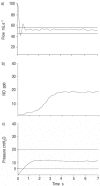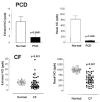Assessment of airway inflammation with exhaled NO measurement
- PMID: 19582178
- PMCID: PMC2464270
Assessment of airway inflammation with exhaled NO measurement
Abstract
Assessing airway inflammation is important for investigating the underlying mechanisms of many lung diseases, including asthma, chronic obstructive pulmonary disease (COPD), bronchiectasis, primary ciliary dyskinesia (PCD) and cystic fibrosis. A growing interest has recently directed toward non-invasive methods for the assessment of airway inflammation. Measurement of exhaled nitric oxide in exhaled air is an exciting innovative technique that gives new insights into the pathophysiology of lung disease and asthma in particular, with many potential clinical applications. Careful standardisation of measurement techniques has facilitated the use of this new measurement in paediatric respiratory medicine. Non-invasiveness and instantaneous results potentially make it a suitable instrument for use in children starting from the age of 4, with useful applications both in asthma diagnosis and monitoring.
Keywords: airway inflammation; asthma; cystic fibrosis; exhaled nitric oxide; non-invasive monitoring; primary ciliary dyskinesia.
Figures




Similar articles
-
Measurement of exhaled nitric oxide in children, 2001.Eur Respir J. 2002 Jul;20(1):223-37. doi: 10.1183/09031936.02.00293102. Eur Respir J. 2002. PMID: 12166573
-
[Measurement of exhaled nitric oxide fraction in lung diseases].Rev Med Chil. 2021 Aug;149(8):1173-1181. doi: 10.4067/s0034-98872021000801173. Rev Med Chil. 2021. PMID: 35319704 Review. Spanish.
-
Biomarkers of some pulmonary diseases in exhaled breath.Biomarkers. 2002 Jan-Feb;7(1):1-32. doi: 10.1080/13547500110104233. Biomarkers. 2002. PMID: 12101782 Review.
-
Clinical aspects of exhaled nitric oxide.Eur Respir J. 2000 Oct;16(4):781-92. doi: 10.1183/09031936.00.16478100. Eur Respir J. 2000. PMID: 11106225 Review.
-
[Exhaled nitric oxide: a new biomarker for respiratory pathologies].Rev Med Liege. 2006 Jan;61(1):37-42. Rev Med Liege. 2006. PMID: 16491547 Review. French.
Cited by
-
Airway Thiol-NO Adducts as Determinants of Exhaled NO.Antioxidants (Basel). 2021 Sep 26;10(10):1527. doi: 10.3390/antiox10101527. Antioxidants (Basel). 2021. PMID: 34679661 Free PMC article.
-
Metabolic alterations in the sera of Chinese patients with mild persistent asthma: a GC-MS-based metabolomics analysis.Acta Pharmacol Sin. 2015 Nov;36(11):1356-66. doi: 10.1038/aps.2015.102. Acta Pharmacol Sin. 2015. PMID: 26526201 Free PMC article.
-
Biomarkers of Human Cardiopulmonary Response After Short-Term Exposures to Medical Laser-Generated Particulate Matter From Simulated Procedures: A Pilot Study.J Occup Environ Med. 2016 Sep;58(9):940-5. doi: 10.1097/JOM.0000000000000832. J Occup Environ Med. 2016. PMID: 27465102 Free PMC article.
-
Role of Inflammatory Risk Factors in the Pathogenesis of Streptococcus pneumoniae.Front Immunol. 2018 Oct 2;9:2275. doi: 10.3389/fimmu.2018.02275. eCollection 2018. Front Immunol. 2018. PMID: 30333833 Free PMC article. Review.
-
Associations between Second-Hand Tobacco Smoke Exposure and Cardiorespiratory Fitness, Physical Activity, and Respiratory Health in Children.Int J Environ Res Public Health. 2021 Oct 30;18(21):11445. doi: 10.3390/ijerph182111445. Int J Environ Res Public Health. 2021. PMID: 34769962 Free PMC article.
References
-
- American Thoracic Society. Standards for the diagnosis and care of patients with chronic obstructive pulmonary disease (COPD) and asthma. Am Rev Respir Dis. 1987;136:225–244. - PubMed
-
- Rytila P, Metso T, Heikkinen K, Saarelainen P, Helenius IJ, Haahtela T. Airway inflammation in patients with symptoms suggestive of asthma but with normal lung function. Eur Respir J. 2000;16:824–830. - PubMed
-
- Toorn LM, Prins J, Overbeek SE, et al. Airway inflammation is present during clinical remission of atopic asthma. Am J Respir Crit Care Med. 2001;164:2107–2113. - PubMed
-
- Green RH, Brightling CE, McKenna S, et al. Asthma exacerbations and sputum eosinophil counts: a randomised controlled trial. Lancet. 2002;360:1715–1721. - PubMed
-
- Vignola AM, Rennar SI, Hargreave FE, et al. Standardised methodology of sputum induction and processing. Future directions. Eur Respir J. 2002;20(Suppl. 37):51s–55s. - PubMed
LinkOut - more resources
Full Text Sources
